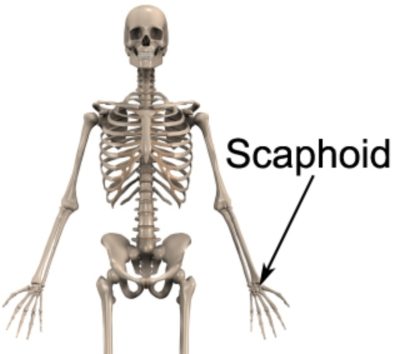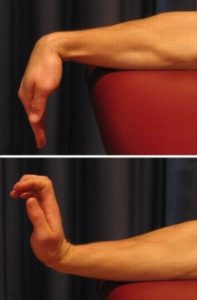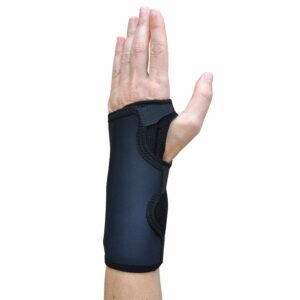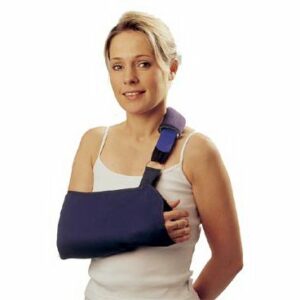Scaphoid Fracture
Updated:
(Also known as a Fracture of the Scaphoid, Fractured Scaphoid)
What is a scaphoid fracture?
A scaphoid fracture is a relatively common condition characterized by a break in one of the small bones of the wrist known as the scaphoid (figure 1).

The wrist comprises of 8 small bones situated between the forearm bones (radius and ulnar) and the bones of the hand. The scaphoid bone lies in a space between the radius (outer arm bone) and the base of the thumb (figure 1).
During certain activities, such as a fall on the outstretched hand, stress is placed on the scaphoid bone. When this stress is traumatic and beyond what the bone can withstand a break in the scaphoid may occur. This condition is known as a scaphoid fracture.
Cause of a scaphoid fracture
A scaphoid fracture most commonly occurs due to a traumatic weight bearing force through the wrist such as a fall onto an outstretched hand. This may occur with any fall, but is particularly common in sports such as skateboarding or snowboarding (particularly in icy conditions) where a fall onto a hard surface is unforgiving.
Signs and symptoms of a scaphoid fracture
Patients with this condition typically experience significant wrist pain at the time of injury. Pain is usually felt on the thumb side of the wrist and can occasionally settle quickly leaving patients with an achiness of the wrist that is particularly prominent at night or first thing in the morning. Patients with a scaphoid fracture may also experience swelling and pain on firmly touching the scaphoid bone on the thumb side of the wrist. Other symptoms associated with this condition may include reduced grip strength and pain on weight-bearing through the affected wrist (e.g. doing a hand stand or push up).
Diagnosis of a scaphoid fracture
A thorough subjective and objective examination from a physiotherapist is essential to assist with diagnosis of a scaphoid fracture. Investigations such as an X-ray, MRI, CT scan or bone scan are usually required to confirm diagnosis. Follow up X-rays at 10-14 days following injury may be required in those cases where a scaphoid fracture is suspected, but initial X-rays have proven inconclusive (as a scaphoid fracture can be more easily seen on X-ray following this time period).
Treatment for a scaphoid fracture

Members Only ContentBecome a PhysioAdvisor Member to gain full access to this exclusive content. For more details see Become a Member. Already a member? Login Now
Prognosis of a scaphoid fracture
Most patients with a fractured scaphoid make a full recovery with appropriate management. Return to activity or sport can usually take place in weeks to months and should be guided by the treating physiotherapist and specialist. However, because the blood supply to the scaphoid can be affected following a fracture and, that initial x-rays sometimes fail to detect a scaphoid fracture, some patients’ recovery may be prolonged or complicated. Complications can include the risk of delayed union, non-union, incomplete union, bony necrosis or osteoarthritis. In patients with severe injuries involving damage to other bones, soft tissue, nerves or blood vessels, recovery time may be significantly prolonged.
Physiotherapy for a scaphoid fracture

Members Only ContentBecome a PhysioAdvisor Member to gain full access to this exclusive content. For more details see Become a Member. Already a member? Login Now
Other intervention for scaphoid fracture

Members Only ContentBecome a PhysioAdvisor Member to gain full access to this exclusive content. For more details see Become a Member. Already a member? Login Now
Exercises for a scaphoid fracture
The following exercises are commonly prescribed to patients with a scaphoid fracture following confirmation that the fracture has healed, and, removal of the plaster cast (or, sometimes, following surgery to stabilize the fracture with screws). You should discuss the suitability of these exercises with your physiotherapist prior to beginning them.
Generally, they should be performed 3 times daily and only provided they do not cause or increase symptoms.Your physiotherapist can advise when it is appropriate to begin the initial exercises and eventually progress to the intermediate, advanced and other exercises. As a general rule, addition of exercises or progression to more advanced exercises should take place provided there is no increase in symptoms.
Initial Exercises
Elbow Bend to Straighten
Bend and straighten your elbow as far as you can go without pain and provided you feel no more than a mild to moderate stretch (figure 2). Repeat 10 times provided there is no increase in symptoms.

Wrist Bends
Begin this exercise with your forearm supported by a table or bench and your wrist and fingers over the edge (figure 3). Slowly bend your wrist forwards and backwards as far as you can go without pain and provided you feel no more than a mild to moderate stretch. Repeat 10 times provided the exercise is pain free.

Forearm Rotations
Begin this exercise with your elbow at your side and bent to 90 degrees (figure 4). Slowly rotate your palm up and down as far as you can go without pain and provided you feel no more than a mild to moderate stretch. Repeat 10 times provided the exercise is pain free.

More Initial Exercises

Members Only ContentBecome a PhysioAdvisor Member to gain full access to this exclusive content. For more details see Become a Member. Already a member? Login Now
Intermediate Exercises

Members Only ContentBecome a PhysioAdvisor Member to gain full access to this exclusive content. For more details see Become a Member. Already a member? Login Now
Advanced Exercises

Members Only ContentBecome a PhysioAdvisor Member to gain full access to this exclusive content. For more details see Become a Member. Already a member? Login Now
Other Exercises

Members Only ContentBecome a PhysioAdvisor Member to gain full access to this exclusive content. For more details see Become a Member. Already a member? Login Now
Rehabilitation Protocol for a Scaphoid Fracture

Members Only ContentBecome a PhysioAdvisor Member to gain full access to this exclusive content. For more details see Become a Member. Already a member? Login Now
 Physiotherapy products for a scaphoid fracture
Physiotherapy products for a scaphoid fracture
Some of the most commonly recommended products by physiotherapists to hasten healing and speed recovery in patients with a scaphoid fracture include:
To purchase physiotherapy products for a fractured scaphoid click on one of the above links or visit the PhysioAdvisor Shop.
 Find a Physio for a scaphoid fracture
Find a Physio for a scaphoid fracture
Find a Physiotherapist in your local area who can treat this condition.
 More Useful Exercises
More Useful Exercises
- Wrist Strengthening Exercises.
- Wrist Flexibility Exercises.
- Hand Strengthening Exercises.
- Hand Flexibility Exercises.
- Arm Strengthening Exercises.
- Arm Stretches.
 More information
More information
- Ice or Heat.
- R.I.C.E. Regime.
- Wrist Taping.
- Thumb Taping.
- Returning to Sport.
- Why is my injury not improving?
- Wrist & Hand Diagnosis Guide.
Become a PhysioAdvisor Member

Link to this Page
If you would like to link to this article on your website, simply copy the code below and add it to your page:
<a href="https://physioadvisor.com.au/injuries/wrist-hand/scaphoid-fracture”>Scaphoid Fracture – PhysioAdvisor.com</a><br/>A scaphoid fracture is characterised by a break in one of the small bones of the wrist known as the scaphoid. Explore its causes, symptoms and treatment now.
Return to the top of Scaphoid Fracture.










